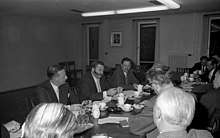Bruce McKenzie
Bruce Roy McKenzie DSO DFC (1 January 1919 – 24 May 1978) was a South African-born Kenyan politician. He was the Minister of Agriculture in Kenya[1] during the presidency of Jomo Kenyatta, to whom he was an adviser.[2] He is alleged to have been an agent for British, South African or Israeli intelligence[3] by various people. He was assassinated on the orders of Ugandan dictator Idi Amin.
Bruce Roy McKenzie | |
|---|---|
 Bruce McKenzie second from left. | |
| Born | 1 January 1919 Richmond, Natal Province, Union of South Africa |
| Died | 24 May 1978 (aged 59) above Ngong Hills, Kenya |
| Cause of death | Time bomb |
| Education | Hilton College, Natal, South Africa |
| Title | Kenyan Minister of Agriculture |
Early life
McKenzie was born in 1919 in Richmond in the Union of South Africa's Natal Province. He joined the South African Air Force in 1939, and was seconded during World War II to Britain's Royal Air Force, with which he saw action in North Africa, the Mediterranean and European theatres. Following his air force service, he emigrated to Kenya in 1946 and became a prominent farmer in Nakuru.[4]
Political career
In January 1976, McKenzie was involved in the kidnapping of two German and three Arab suspected terrorists wanted by Israel for an attempted missile attack on an El Al airliner taking off from the airport of Nairobi.[5] The five were secretly transported to Israel and later sentenced to long prison terms.[6]
In late June 1976, during Operation Entebbe, McKenzie persuaded Kenyan President Kenyatta to permit Mossad to collect intelligence prior to the operation, and to allow the Israeli Air Force access to the Nairobi airport.[7] Before the operation, McKenzie assisted a Mossad agent who flew a small plane to Entebbe to take aerial photographs of the airport installations and parked fighter jets which were destroyed by the Israeli troops in the raid.[3]
In retaliation, Ugandan President Idi Amin ordered Ugandan agents to assassinate McKenzie. He was killed on 24 May 1978 when a bomb attached to his aircraft exploded.[2][7][8][9] The bomb was reportedly concealed inside either a mounted antelope head or a carved wooden statue in the form of a lion's head McKenzie had been presented as a gift from Idi Amin just prior to the flight.[10][11]
McKenzie was survived by his wife, Christina, three sons[12] and two daughters. Later, Mossad Chief Director Meir Amit had a forest planted in Israel in McKenzie's name.[7]
References
- Kenya Gazette. 11 May 1966. p. 500. Retrieved 5 January 2013.
- "Ugandan agents killed former Cabinet minister, says dossier". Standard Digital News. Retrieved 26 September 2013.
- Oluoch, Fred (22 July 2013). "Spy who was killed in plane crash" (PDF). The Daily Nation. Archived from the original (PDF) on 10 August 2014. Retrieved 21 July 2014.
- Maxon, Robert M. (2014). Historical Dictionary of Kenya. ISBN 978-0810874695.
- Kahana, Ephraim (2006). Historical Dictionary of Israeli Intelligence. Oxford: Scarecrow Press. p. 171. ISBN 9780810865006. Retrieved 21 July 2014.
- "Two German Terrorists Repatriated Before Completing 10-year Term". JTA.org. Jewish Telegraphic Agency. 26 December 1980. Retrieved 21 July 2014.
- Melman, Yossi. "A history of cooperation between Israel and Kenya". JPost. Retrieved 26 September 2013.
- Kahana, Ephraim (2006). Historical Dictionary of Israeli Intelligence. Scarecrow Press. p. 171. ISBN 978-0-8108-6500-6.
- Dunstan, Simon (2011). Entebbe: The Most Daring Raid of Israel's Special Forces. The Rosen Publishing Group, Inc. p. 58. ISBN 978-1-4488-1868-6.
- Gawaya-Tegulle, Tom (7 September 1997). "Background Article: Angry Amin Takes Revenge (Entebbe Raid Part 4)". The Monitor. Archived from the original on 20 October 2007. Retrieved 21 July 2014.
- Cooper, Carole (1993). Kenya: The National Epic. Nairobi: East African Publishers. p. 209.
- "Person Page". thepeerage.com. Retrieved 22 October 2018.
External links
- The Making of Idi Amin, Pat Hutton and Jonathan Bloch, New African, February 2001.
- Who Put Gen. Idi Amin in Power?, Workers' Daily, 2 April 2002, extract from an article published by The Monitor (Uganda) on 31 March 2002.